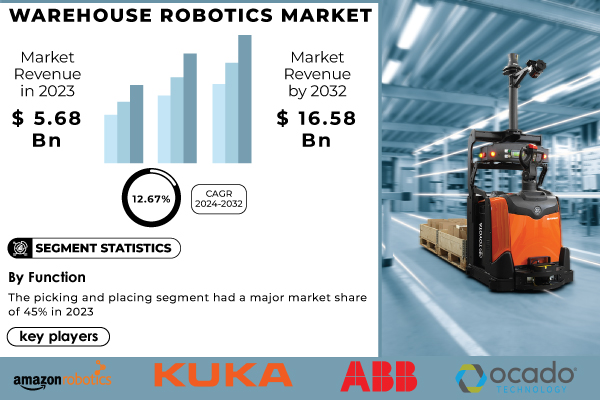The Warehouse Robotics Market was valued at USD 5.68 Billion in 2023 and is projected to reach USD 16.58 Billion by 2032, growing at a CAGR of 12.67% during the forecast period from 2024 to 2032.
The warehouse robotics market is rapidly transforming with the advent of automation technologies and the growing demand for efficiency in logistics and supply chain management. Robotic systems, which are created to automate a plethora of warehouse features, are being progressively used against the backdrop of the rise of e-commerce, changing customers’ habits, and rising demands to reduce operational costs. The key tendency behind the market transformation is the global interest in automation driven by rapidly growing labor costs, lack of workforce, and long supply chains. Therefore, companies are interested in finding technologies and solutions that would help their warehouses operate more effectively and further diminish the human factor. With higher and skyrocketing labor prices, more and more companies opt for automation, and, as a result, the warehouse automation market is expected to grow up to USD 30 billion by 2026, from USD 23 billion in 2023.
Top Market Players Listed in this Research Report are:
- Amazon Robotics (Kiva Systems, Amazon Prime Air)
- KUKA Robotics (KMP 1500, KUKA omniMove)
- Fetch Robotics (Freight 500, Freight 1500)
- ABB Robotics (YuMi, IRB 6700)
- Ocado Technology (Oconveyor, Smart Platform)
- Clearpath Robotics (OTTO 100, OTTO 750)
- Geek+ (P800, P2000)
- Locus Robotics (LocusBot, LocusFleet)
- Siemens (Siemens SIMATIC, Siemens Logistics)
- Mujin (Mujin Controller, Mujin Manipulator)
- Mobile Industrial Robots (MiR) (MiR100, MiR200)
- Robotiq (Robotiq 2F-85, Robotiq Wrist Camera)
- Seegrid (G2 Autonomous Mobile Robot, Palion AMRs)
- Yaskawa (MOTOMAN-HP, Yaskawa Smart Pendant)
- Vecna Robotics (Vecna Robotics AMRs, Vecna Warehouse Management)
- Cobalt Robotics (Cobalt Security Robot, Cobalt Inventory Management)
- Balyo (Balyo AGV, Balyo Forklift)
- Pinc Solutions (Pinc’s Real-Time Location System, Pinc Inventory Management)
- FANUC (M-20iA, M-710iC)
- 6 River Systems (Chuck, 6 River Systems Cloud)
Warehouse Robotics Market Report Scope:
| Report Attributes | Details |
| Market Size in 2023 | USD 5.68 Billion |
| Market Size by 2032 | USD 16.58 Billion |
| CAGR | CAGR of 12.67% From 2024 to 2032 |
| Key Segments | • By Type (Autonomous Mobile Robots (AMRs), Automated Guided Vehicles (AGVs), Articulated Robots, Cylindrical & SCARA Robots, COBOTS, Others) • By Function (Picking & Placing, Palletizing & De-palletizing, Transportation, Sorting & Packaging) • By Payload Capacity (Less than 20kg, 20-100 kg, 100-200 kg, Greater than 200kg) • By End User (Automotive, Semiconductor & Electronics, Chemical, E-Commerce & 3PL, Food & Beverage, Healthcare, Metals & Heavy Machinery, Others) |
| Key Drivers | • Driving efficiency and customer satisfaction in the warehouse robotics market through automation and advanced technologies. • Rapid growth of warehouse robotics market driven by e-commerce expansion and automation needs. |
“Comprehensive Segment Breakdown Highlights Emerging Opportunities in the Market”
- By Type: Automated Guided Vehicles (AGVs) held the largest share in the Warehouse Robotics Market in 2023 with a 40% market share. They are created to move materials within a site automatically, following set paths guided by magnetic strips, lasers, or vision systems. AGVs are crucial in modern warehouses and distribution centers because they greatly improve efficiency, lower labor expenses, and decrease human mistakes.
- By Function: The picking and placing segment had the highest market share of 45% in 2023. The rising need for efficient and accurate inventory management mechanisms is driving the workforce to adopt these devices. These robots can choose the correct products, put them correctly, and understand their capacity to make improvements. The error rate is drastically reduced when using these devices, boosting productivity. The online buying frequency has increased, and the population is now demanding faster delivery.
- By Payload Capacity: The 20-100 kg segment led the market in 2023 with 48% market share. These robots are flexible and capable of managing a variety of tasks such as selecting, categorizing, and handling objects. They have the appropriate size, capability, and cost to carry out numerous warehouse activities. Amazon utilizes robots like the Kiva system to expand its productivity in its fulfillment center because of its effectiveness.
“Unlocking Regional Opportunities: In-Depth Market Insights and Forecasts”
APAC region captured the highest market share of 44% in 2023 and dominated the market. The increasing industrialization, growing economies, expanding business needs, and advanced technology requirements made the APAC region dominate the market. China, Japan, and China are ahead in their innovation and implementation of many of the application sectors such as electronics, manufacturing, and the information technology sector. The region’s strong industrial base can be seen in the presence of major players like LG Innotek in South Korea and Tata Group in India.
Europe is anticipated to be the fastest-growing region in the period of 2024-2032. Green initiatives and a strong focus on sustainability will drive growth in the region. The European Union’s standards of environmental regulations are specifically strict and cap tight regulations on carbon emissions. It has encouraged investment in green technologies and innovations. Europe has also committed significant investments in research and development, with much of it being funded by both public and private sources.
Recent Developments
- June 2023: Automation Anywhere unveiled a new AI-powered robotic system capable of performing complex warehouse tasks such as inventory management and quality control.
- August 2023: Kiva Systems (an Amazon company) announced an upgrade to its fleet of AGVs, introducing advanced navigation capabilities that enhance their efficiency in dynamic warehouse environments.
Key Takeaways
- The Warehouse Robotics Market is set for significant growth, with a projected value of USD 16.58 Billion by 2032, reflecting a growing trend towards automation in logistics.
- Autonomous Mobile Robots (AMRs) are the dominant segment, driven by their versatility and ability to improve operational efficiency.
- North America leads the market, while Asia Pacific emerges as the fastest-growing region, both driven by rising automation demands in warehouse operations.
- Recent advancements in robotic technologies are transforming warehouse operations, paving the way for more efficient and cost-effective logistics solutions.





